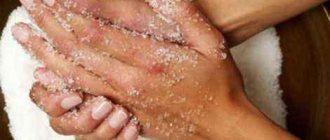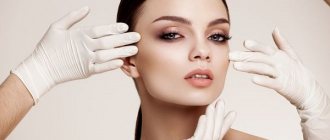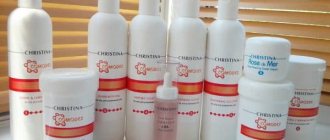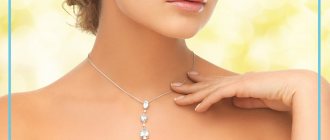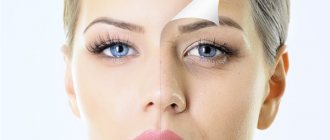The benefits and effectiveness of peptide facial peeling
Based on the name, it becomes clear that this product is based on peptides - molecules containing amino acids. Their main feature is their easy penetration into the middle layers of the epidermis due to their low molecular weight. There they affect the fibroblasts responsible for the production of collagen. As a result, activation of collagen production and cell renewal on all layers of the dermis.
Peptide peeling contains alpha-hydroxy acids, which thoroughly cleanse the dermis, and in tandem with peptides enhance rejuvenation processes. Today, more than 1,500 peptides are known, but synthetic peptides are most often used for anti-aging techniques.
In addition to regeneration and tightening of fibers, the method has exfoliating properties, thus, peeling with peptides acts comprehensively, replacing a number of other peels, which has been repeatedly confirmed by customer reviews.
This procedure is recommended if you have the following problems:
- aging dermis;
- loss of elasticity, firmness;
- crow's feet around the eyes;
- small and medium wrinkles;
- decreased turgor;
- unclear oval face;
- loose skin;
- disturbed lipid balance;
- acne, comedones, blackheads, and other similar imperfections.
The effectiveness of peptide peeling is revealed in the following visible results:
- fine wrinkles disappear, deep wrinkles smooth out, becoming less noticeable;
- tone and elasticity return;
- the synthesis of collagen and elastin increases;
- pigment spots and freckles lighten;
- the protective properties of the epidermis are increased;
- acne and comedones go away;
- the relief of the face is smoothed;
- the oval of the face is tightened;
- double chin and sagging skin are corrected;
- the skin is moisturized and does not flake.
Who is the procedure recommended for?
Peptide peeling is suitable for women whose skin is characterized by the following symptoms:
- flabbiness, atonicity, fine network of wrinkles;
- tissues are dry and dehydrated;
- the presence of deep facial wrinkles;
- “crow’s feet” in the area around the eyes;
- decreased elasticity and skin turgor;
- Acne, sebaceous plugs and comedones periodically appear due to lipid imbalance.
The main indicator that you need to attend the procedure is multiple deep wrinkles. If your face resembles a baked apple, then feel free to go to a cosmetologist. Of course, in the absence of contraindications.
Are there any contraindications and side effects?
Most cosmetic procedures have a number of contraindications. Despite its high effectiveness and the absence of surgical intervention, peeling with peptides is no exception.
The method is contraindicated in the following cases:
- allergies or individual intolerance to the components included in the composition;
- mechanical damage to the epithelium;
- fresh tan;
- fungal and other skin diseases;
- pregnancy, lactation period;
- hypertension;
- diseases of the heart and cardiovascular system;
- diabetes.
Contraindications to the procedure also include taking retinol and recent hair removal. After depilation, at least 14 days must pass on the treated area, and before peptide cleansing, the use of vitamin A should be avoided.
Contraindications
The possibility of skin peeling with peptides is excluded if you have:
- Fresh tan;
- Abrasions, open wounds on the face or other violations of the integrity of the skin;
- Allergic reaction to individual components;
- Diseases of a dermatological nature;
- ARVI, cold or general malaise;
- Increased body temperature, herpes rash;
- Oncology and diabetes;
- Hypertension and diseases of the cardiovascular system;
- When using medications with retinol and its derivatives;
- During pregnancy;
- When breastfeeding;
- If the last hair removal was done less than 2 weeks ago;
- If you have recently (less than 2 months) undergone surgery or other traumatic procedures.
Despite the mild effect on the epidermis, peeling with peptides is a chemical cosmetology procedure, so neglecting contraindications can negatively affect your health and increase skin problems.
Peptide peeling procedure protocol
Peptide peeling involves some preparation for the procedure. In addition to stopping the use of retinol and observing the time interval after depilatory manipulations, a couple of months before the procedure, you should refrain from traumatic techniques. This can be dermabrasion, laser and other resurfacing.
Before carrying out peptide peeling, an express test is carried out for the presence of irritant reactions, and the specialist must also collect an anamnesis, taking into account the individual characteristics of the body and possible contraindications.
The procedure consists of the following stages:
- Cleansing. The skin is always thoroughly cleansed with special softening compositions for washing. The cosmetologist removes remnants of makeup and atmospheric pollution. For this, glycolic acid, argan or other oil is used, depending on the skin type. Additionally, the face can be toned.
- The face is treated with a special composition based on lactic, glycolic or salicylic acid.
- Then a peptide cleanser is applied, the concentration of which depends on the type of dermis and the expected result. The procedure is absolutely painless and atraumatic, so no anesthesia is required. The most popular product among cosmetologists is Power Alpha peptide Resurfacer, but analogues can also be used.
- Using a brush or spatula, distribute the product over the face, neck or décolleté. To enhance the effect of the active substances, it is advisable to massage the treated area. The composition remains on the skin for 10 minutes (the time is determined by the specialist individually).
- Next, the composition is removed using neutralizers. Sodium citrate contained in this product helps to quickly and completely remove peptide residues from the face. First, wash it, then apply a cold compress with a neutralizing agent for 10 minutes.
- At the last stage, the skin needs to be moisturized and soothed with the help of cosmetic nourishing creams or masks. Various serums are often used.
- It is recommended to treat your face with sunscreen and only then go outside.
The peptide peeling procedure can last up to 40 minutes - it all depends on the complexity of the problem being solved and the individual characteristics of each client. A cleansing course consisting of 5-10 procedures is carried out 1-2 times a year. It can be used as an independent method of rejuvenation, or as a preparatory manipulation before more serious rejuvenating procedures.
We invite you to watch the video. how the procedure is carried out:
Peptide peeling technique
To prevent the occurrence of negative reactions of the epidermis to the action of aggressive components and facilitate the course of the recovery process, it is necessary to prepare the face for the procedure. Two weeks before the expected time of cleansing, stop taking retinoids internally and using them externally. Within two months, traumatic procedures that expose the surface layers of the epidermis are stopped. Three days before the session, you should stop taking medications for the treatment of acne that contain benzoyl peroxide. If the patient has herpes, even in remission, it is necessary to undergo a preventive course of treatment three weeks before peeling. Peptide peeling requires a mandatory test for sensitivity to the components of the composition. This is usually done a day before the procedure.
Step-by-step procedure:
- First of all, the face must be cleaned of makeup residues, disinfected and degreased. For this purpose, gels based on glycolic acid are used for oily skin and milk with argan oil for dry epidermis and delicate structure.
- To tone the tissues, apply a moisturizing tonic spray containing hyaluronic acid and lavender extract.
- To prepare the epidermis for the direct impact of the cleansing composition, apply a universal product with 10% glycolic, 2% salicylic, 1% lactic acids.
- The peptide peel itself involves applying a composition to the face, the power of which depends on the characteristics of the skin and the desired result. The holding time is calculated by the specialist performing the procedure.
- To remove the cleansing mass from the surface of the face and stop its effects, a universal neutralizer based on sodium citrate is used.
- A mandatory stage of each session is the use of moisturizing, nourishing and soothing products. For this purpose, specialized serums are used that can provide all of the above effects. They may contain hyaluronic acid and panthenol. No less often, specific serums are used that enhance the rejuvenating effect of the compositions, relieve inflammation and redness, and accelerate tissue regeneration.
- The finishing touch should be applying sunscreen.
The course of such peeling consists of 6-10 procedures, which are carried out every 1-2 weeks. To obtain the most lasting effect, this treatment option is recommended to be carried out once every six months or a year. Peptide peeling can act as an independent procedure or be part of a complex of anti-aging measures.
Skin care after peptide peeling, the result of the procedure
Skin care after the procedure should be carried out in accordance with the cosmetologist’s instructions, taking into account the characteristics of the epidermis. The period of use of restorative drugs is also prescribed by a specialist. Usually the use of moisturizing, anti-inflammatory, and antioxidant agents is prescribed twice a day. Be sure to apply sunscreen before going outside for at least one month. During the entire rejuvenation course and three weeks after the final procedure, visiting the solarium is prohibited. For the first three days after peeling, you should refrain from visiting the sauna or bathhouse. Physical activity should be avoided and the use of decorative cosmetics is not recommended.
If all the specified conditions are met, peptide peeling gives the following results:
- The dermis layer thickens and strengthens, causing tension on the surface of the face. Wrinkles are smoothed out, folds become less pronounced, the facial contour becomes clearer;
- the synthesis of collagen and elastin increases significantly;
- the skin is tightened due to a pronounced lifting effect;
- pigment spots and freckles are lightened, skin color is evened out;
- the skin becomes fresh, soft, smooth and even;
- the protective functions of the epidermis are restored;
- tissues are intensively moisturized and nourished.
The effectiveness of this type of care is obvious after the first procedure, but the final result will be visible only after completing the full course of sessions.
If tissue sensitivity is increased or peeling technique is violated, the following complications may develop:
- Severe swelling and redness of the epidermis.
- Itching, burning, tingling that does not go away for several hours.
- Increasing the sensitivity of tissues to environmental conditions, ultraviolet radiation, and cosmetics.
- Hyperpigmentation and the appearance of areas of flaking.
- Exacerbation of herpes, tissue infection.
- Allergic reaction.
- Worsening of acne and comedones.
How to care for your skin after procedures?
A prerequisite for post-procedure skin care is the use of moisturizing and nourishing products with a healing effect. These can be products with panthenol, Solcoseryl, retinoic ointment, Tocopherol, Bepanten, etc. All of them are available in the pharmacy at affordable prices.
Peptide peeling eliminates any type of tanning for a month after cleansing. It is advisable not to visit a bathhouse or sauna, and to refrain from intense physical activity.
If these recommendations are not followed or due to improper actions by the cosmetologist, the following side effects may occur:
- peeling;
- swelling;
- hyperemia;
- itching;
- redness;
- burning.
Attention! In case of pronounced negative effects, you should immediately contact a dermatologist or the specialist who performed the peeling. If necessary, he will prescribe treatment.
Indications and contraindications for alpha peptide peeling procedure
This cosmetic procedure is necessary if the patient has loose, thin skin, or if the type of aging is finely wrinkled. In the event that photoaging is observed and the skin is dehydrated. Clients with deep expression lines and a network of minor superficial wrinkles also benefit from alpha-peptide peeling. It is prescribed for decreased skin elasticity and crow's feet in the corners of the eyes.
The procedure is contraindicated for those who are allergic to one of the components of the peeling composition, if the skin is damaged, with aggravated herpes, fresh tan, skin infection, as well as with neoplasms, diabetes, hypertension and colds. Such procedures are harmful for pregnant and breastfeeding mothers, people who had hair removal in the facial area 10 days ago.
Women's reviews of peptide peeling
Before carrying out a new procedure, to which the skin’s reaction is still unknown, and the result itself is seen as a distant mirage, it is better to read the reviews of real clients who have undergone the procedure. To facilitate this task, objective reviews from patients in beauty salons and clinics were selected.
Lyudmila, 45 years old:
“Peptide peeling is a fairly effective procedure, but you shouldn’t expect magical results. Peptides perfectly fight wrinkles, lighten age spots and tighten sagging skin. In 8 procedures, I tightened the flabby skin on my chin, and there was no trace left of the dark circles under my eyes.”
Irina, 51 years old:
“Due to severe flaking and dryness, I turned to a cosmetologist who recommended peptide cleansing. It does not cause any unpleasant sensations, has an affordable cost compared to other procedures, and most importantly, with high efficiency, it does not require instrumental intervention. Now my face has become fresher, my skin is more elastic and velvety. I don’t regret what I did.”
Olga, 39 years old:
“I came across peptide cosmetics a year ago when I did alpha-peptide peeling. To eliminate the first signs of aging, I needed 7 procedures with an interval of 1 week. Now your skin literally glows: clean, smooth and healthy. I fell in love with peptide products so much that now to maintain this beauty I use products from the Revilin line, also with peptides.”
What do peptides do for the skin?
- Stabilize and support the processes of cell restoration and renewal.
- Maintains optimal rate of cell division.
- Stimulate fibroblasts and the synthesis of dermal matrix components (collagen, elastin, hyaluronic acid).
- Strengthens collagen and elastin fibers.
- Restores firmness and elasticity.
- Increases skin turgor and density.
- Tighten the oval of the face.
- Stimulate regeneration.
- Relaxes muscles.
- Smoothes out wrinkles, including facial wrinkles.
- They work to prevent premature skin aging.
- Strengthens the skin's antioxidant protection.
- Inhibits the inflammatory process.
- They heal.
- Strengthens lymphatic drainage, relieves swelling.
- Stimulate microcirculation.
- Reduces the manifestations of rosacea.
- Lighten pigmentation.
- Evens out complexion.
The properties of peptides - their ability to penetrate the skin, action and effectiveness - are determined by the sequence of amino acids in the chain. Little commanders have order everywhere - a specific peptide is responsible for each signal. Therefore, one product usually contains several peptides. The more functions a cream has, for example, the richer its filling and peptide composition will be.
Preparing for peeling
1. 2 weeks before the procedure, taking retinols is prohibited.
2. Hair removal on the face is prohibited 10 days before peeling.
3. Dermabrasion or laser resurfacing - no earlier than 2 months before alpha-peptide peeling.
4. Drugs containing benzoyl peroxide are discontinued within 3-4 days.
5. 2-3 weeks before alpha-peptide peeling, prevention (if any) of herpes is carried out.
6. The day before, conduct a sensitivity test.

